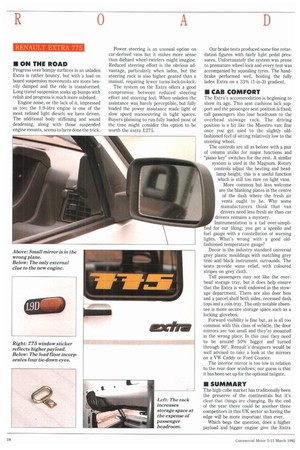RENAULT EXTRA 775
Page 30

Page 31

If you've noticed an error in this article please click here to report it so we can fix it.
• ON THE ROAD
Progress over bumpy surfaces in an unladen Extra is rather bouncy, but with a load on board suspension movements are more heavily damped and the ride is transformed. Long travel suspension soaks up bumps with relish and progress is much more subdued.
Engine noise, or the lack of it, impressed us too; the 1.9-litre engine is one of the most refined light diesels we have driven. The additional body stiffening and sound deadening, along with those suspended engine mounts, seems to have done the trick. Power steering is an unusual option on car-derived vans but it makes more sense than diehard wheel-twirlers might imagine. Reduced steering effort is the obvious advantage, particularly when laden, but the steering rack is also higher geared than a manual, requiring fewer turns lock-to-lock.
The system on the Extra offers a good compromise between reduced steering effort and steering feel. When unladen the assistance was barely perceptible, but fully loaded the power assistance made light of slow speed manoeuvring in tight spaces. Buyers planning to run fully loaded most of the time might consider this option to be worth the extra £275. Our brake tests produced some fine retardation figures with fairly light pedal pressures. Unfortunately the system was prone to premature wheel-lock and every test was accompanied by squealing tyres. The handbrake performed well, holding the fully laden Extra on a 33% (1-in-3) gradient.
• CAB COMFORT
The Extra's accommodation is beginning to show its age. Thin seat cushions lack support and the passenger seat position is fixed; tall passengers also lose headroom to the overhead stowage rack. The driving position is a bit like the Maestro van: fine once you get used to the slightly oldfashioned feel of sitting relatively low to the steering wheel.
The controls are all as before with a pair of column stalks for major functions and "piano key" switches for the rest. A similar system is used in the Magnum. Rotary controls adjust the heating and headlamp height; this is a useful function which is still too rare on light vans. More common but less welcome are the blanking plates in the centre of the dash where the fresh air vents ought to be. Why some manufacturers think that van drivers need less fresh air than car drivers remains a mystery.
Instrumentation is a tad over-simplied for our liking: you get a speedo and fuel gauge with a constellation of warning lights. What's wrong with a good oldfashioned temperature gauge?
Decor is the industry standard universal grey plastic mouldings with matching grey trim and black instrument surrounds. The seats provide some relief, with coloured stripes on grey cloth.
Tall passengers may not like the overhead storage tray, but it does help ensure that the Extra is well endowed in the stowage department. There are also door bins and a parcel shelf both sides, recessed dash tops and a coin tray. The only notable absentee is more secure storage space such as a locking glovebox.
Forward visibility is fine but, as is all too common with this class of vehicle, the door mirrors are too small and they're mounted in the wrong place. In this case they need to be around 50% bigger and turned through 90°. Renault's designers would be well advised to take a look at the mirrors on a VW Caddy or Ford Courier, The interior mirror is too low in relation to the rear door windows; our guess is that it has been set up for the optional tailgate.
• SUMMARY
The high-cube market has traditionally been the preserve of the continentals but it's clear that things are changing. By the end of the year there could be another three competitors in this UK sector so having the edge will be more important than ever.
Which begs the question, does a higher payload and bigger engine give the Extra 775 an edge? We remain sceptical about the demand for payload in this class, but buyers might well be tempted by the extra performance.
There's no doubt that the 1.9 diesel is an excellent engine, offering good performance and impressive refinement. Decent fuel consumption would make it a practically unbeatable package. With an excellent laden ride and competitive price, the dubious restyling could be overlooked.
In any case, at £6,930 the Extra 775 must be a good proposition. Even with the optional power steering, it's a lot cheaper than the diesel Ford Courier at £8,060 which is priced to defend Escort van sales. It also squares up well against the Vauxhall Astramax at £8,395. The Seat Terra looks like good value at £5,199, but it can't match the Extra's performance or carrying capacity, leaving Citroen's C15D 765 as a major threat priced at £6,647.
Some of its rivals may have better residual values, related partly to their higher initial price, hut for anyone in the market for a competent high-cube van at a competitive price, the 775 is an attractive buy.
LI by John Kendall












































































































